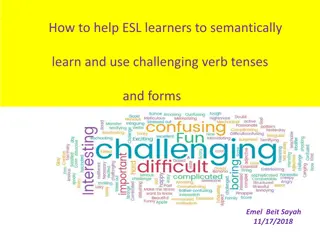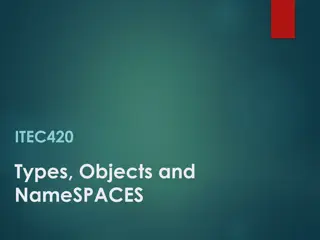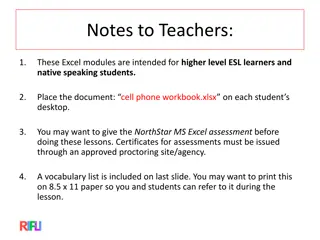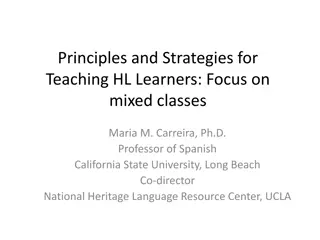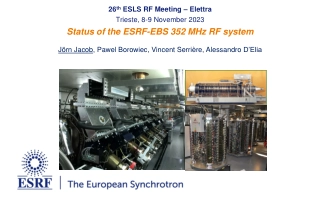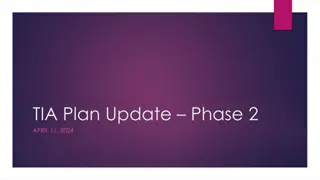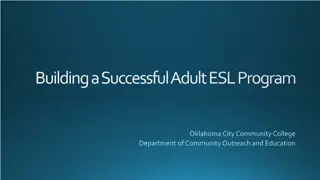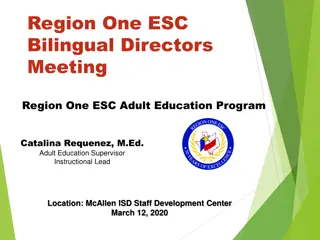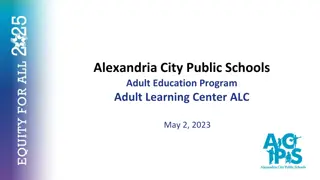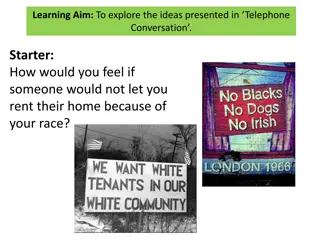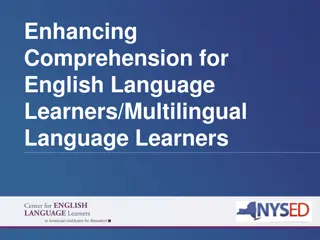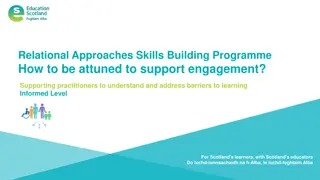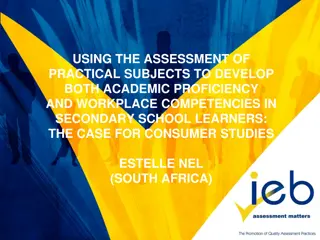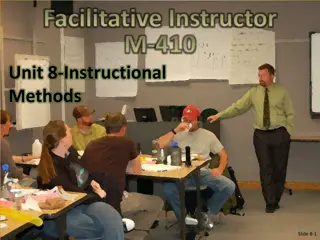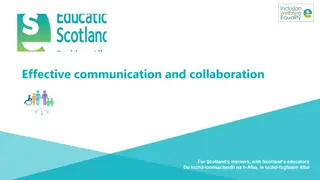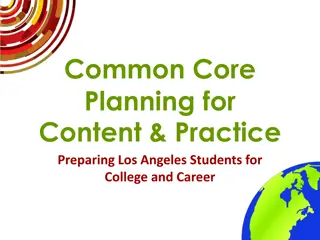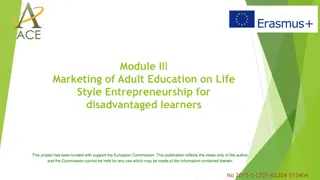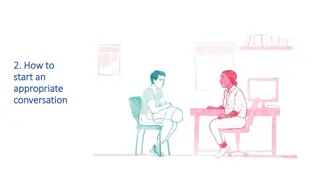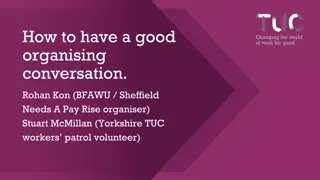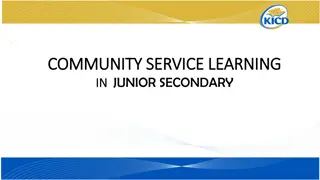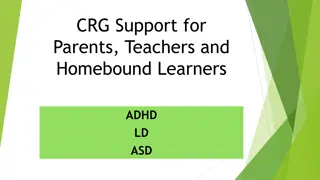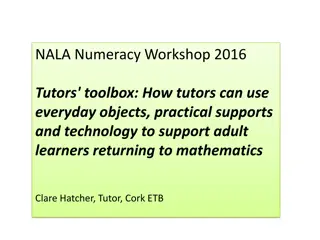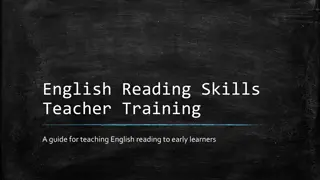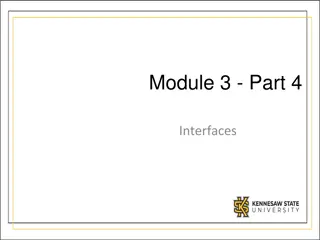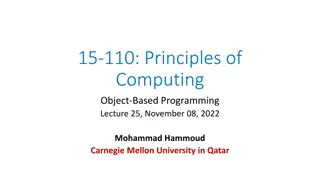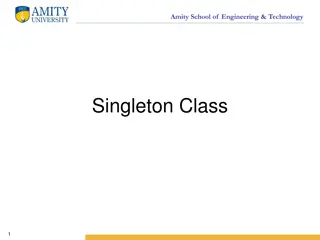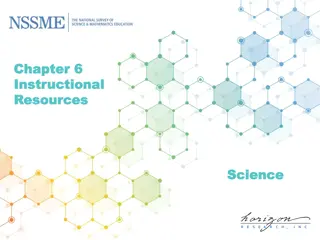Building Effective Conversation Classes for ESL Learners
Understanding the key components of conversation classes, such as student-directed learning, flexible content, and community outreach, is essential for designing engaging and successful sessions. This guide explores strategies for developing interactive ESL courses, leveraging existing resources, and attracting diverse learners through effective advertising and outreach efforts. Additionally, we provide insights on cultivating partnerships and accessing valuable resources to enhance the learning experience for non-native English speakers.
Download Presentation

Please find below an Image/Link to download the presentation.
The content on the website is provided AS IS for your information and personal use only. It may not be sold, licensed, or shared on other websites without obtaining consent from the author. Download presentation by click this link. If you encounter any issues during the download, it is possible that the publisher has removed the file from their server.
E N D
Presentation Transcript
What well talk about Conversation classes What are they Building a class Advertising Class ideas/activities Things to keep in mind Building resources Cultivating what you already have This Photo by Unknown Author is licensed under CC BY-NC-ND
Conversation Classes 101 What constitutes as a convo class? For this presentation, I m going to use conversation class as an umbrella term to refer to any interactive, ESL course or social hour that is not set up in the way of a traditional style class, but functions with the base goal of improving speaking and listening skills Conversation classes are typically student-directed. Facilitation/scaffolding is still present. The amount of direction provided will also depend on the speaking/listening level of the attendees What are some things to keep in mind? Content is flexible. Know what you want to do and find out as much as you can about the community/communities you re trying to reach out to. Do demographic research and find out what your communities need. If you have a class of beginners with only a basic grasp of English, your conversation class will require more instruction and review. This does not mean that you necessarily need to incorporate formal assessment (quizzes, tests, presentation, etc), but you may need to be prepared to teach vocabulary, grammar points, etc.
Conversation Classes 101 How do I build a class? Think about the resources you have/can gain access to What kind of prep are you willing/can you do? Think about the patrons you re trying to reach Think about what you want patrons to take away Skills Socialization Information
Conversation Classes 101 Conversation class vs. traditional style class If your library is new to working with non-native English-speaking populations, I recommend starting with a conversation class instead of a formal traditional style class, or anything requiring registration How do I get people through the door? The communities you re trying to reach will determine how you advertise Call, call, call! Outside partnerships Post! Use social media Get to know your immigrant communities
We Welcome You to Welcome Everyone - Handout Resources Professional Organizations Asian/Pacific American Librarians Association - http://www.apalaweb.org Chinese American Librarians Association - http://www.cala-web.org REFORMA - The National Association to Promote Library and Information Services to Latinos and the Spanish Speaking - http://www.reforma.org Ethnic & Multicultural Information Exchange Round Table - www.ala.org/emiert/ Overview of Key Data Sources Migration Policy Institute: Immigrant Data Matters https://www.migrationpolicy.org/research/immigration-data-matters Public Policy Institute of California http://www.ppic.org/publication/immigrants-in-california/ Demographic Information Data USA https://datausa.io/ Statistical Atlas https://statisticalatlas.com/ Census American Fact Finder https://factfinder.census.gov/ USC Center for the Study of Immigrant Integration: https://dornsife.usc.edu/csii Local Government websites: City, Department of Education Conferences Joint Conference of Librarians of Color http://www.jclcinc.org/ National Immigrant Integration Conference - https://niic2018.org/ Legal Resources and Information USCIS U.S. Citizenship and Immigration Services - https://www.uscis.gov/ Immigration Law Help - www.immigrationlawhelp.org AILA American Immigration Lawyers Association - http://www.aila.org/ United We Dream - https://unitedwedream.org/ BAJI Black Alliance for Just Immigration - http://baji.org/ NILC National Immigration Law Center - www.nilc.org ILRC Immigrant Legal Resource Center - www.ilrc.org Email subscriptions / Listservs USCIS Alerts - https://www.uscis.gov/news/alerts Immigration Advocates Network - https://www.immigrationadvocates.org/ Federal Register - https://www.federalregister.gov/ Welcoming Communities Project Welcome - https://publish.illinois.edu/projectwelcome/ Welcoming America - https://www.welcomingamerica.org/ Black Immigrants in Libraries- https://blackimmigrantsinlibraries.com/ https://americanlibrariesmagazine.org/blogs/the-scoop/serving-immigrants- refugees-public-libraries/ Policy Landscape Migration Policy Institute - https://www.migrationpolicy.org/ Asian Americans Advancing Justice - https://www.advancingjustice-aajc.org/ National Association for Latino Elected Officials - http://www.naleo.org/ Handout from Eva Raison, Brooklyn Public Library
Conversation Classes 101 Possible solutions: For your first couple of conversation classes, you may want to make sure you have enough resources for 10 more than you expect. Avoid an activity which requires a strict number of tools/resources to participate-like a cooking class Be sure to have a couple volunteers on hand, in case you have more patrons, and need help scaffolding Registration Pros: Cons: You ll be a gauge the number of participants you ll have It s easier to keep track of who s who-build a relationship Solidify details- people are clear How will people save a seat? At the library? Over the phone? On the internet? People may be intimidated by needing to register- keep personal details minimal
Conversation Classes 101 Conversation class ideas. How do I get people to talk? For the first lesson or so, you may find yourself initiating conversation Warm-up s/introductions- *Name badges*- first name only Find out why people are there- This will help you sculpt future conversation topics Talk a little bit about yourself and your library, and the community Have a couple games as an ice breaker (my favorite is Jenga- each time someone pulls a wooden piece, they must ask a question to someone else). **Note: Games aren t only restricted to serving as ice breakers. Let them become an integral part of your class Read the room: If your conversation class is lively and people are engaged and self-directing easily, let them keep going. Keep the snacks flowing, and let your attendees keep chatting- unless it has been specifically in demand and is crucial, save the activity for next time.
Conversation Classes 101 Conversation class ideas. How do I get people to talk? The implementation of essential words/phrases- crucial in times of communication breakdown. Hello How are you? My name is I m from I don t understand What does this mean? What is this? Please speak slowly.
Conversation Classes 101 Conversation class ideas. What does a plan look like? Conversation Class lesson plan: 1 Conversation Class lesson plan: 3 Goal: To practice expressing opinions Goal: To practice applying for jobs (reading/writing job application) Key terms/Possible challenges: Expressing I think/I don t think , adjectives Key terms/Possible challenges: Reading job applications/terms Activities: Teaching key terms Activities: Discussing recent event, movie, etc students work on one together) Filling out a mock-application (demonstrate, then have Conversation Class lesson plan: 2 Conversation Class lesson plan: 4 Goal: To practice life-skills/cooking Key terms/Possible challenges: Cooking vocabulary/Listening skills Goal: To practice saying likes and dislikes Activities: Learning kitchen/cooking terminology/vocab; attendees bring their own food/snacks and share/describe recipes Key terms/Possible challenges: Relevant vocabulary Activities: Pair work-asking each other do you like? , learning how to answer in negative
Conversation Classes 101 Condensed ACTFL (American Council on the Teaching of Foreign Languages) guidelines (for speaking) Novice Low- No real functional ability, given time and cues, they may be able to exchange basic information (name, greetings, etc) High- can manage a few formulative questions, can communicate regarding basic tasks, a few objects, immediate needs Intermediate Low- ordering food, self and family, daily activities, uncomplicated, straightforward communication. High- Converse with ease and confidence when dealing with routine tasks and social situations, they can handle talking on a basic level about things like work, interests, etc. Advanced Low- Can speak in several communicative scenarios, can talk about current events, public interest, politics, and can navigate tenses, time frames, and can be understood by native speakers High-well developed ability to speak with ease, can use communicative strategies like paraphrasing, illustration, and can correct errors.
Conversation Classes 101 Things to keep in mind: If you have a large class, try to split students into smaller groups, especially if the program is relatively new. This can help keep anxiety levels about speaking low. Also, keep in mind sounds and sound level. It may be harder for participants to listen effectively if the classroom is loud, or there are multiple people speaking to the whole group at once. Don t try and force anyone to talk. While this seems obvious, and of course we want to encourage all attendees to participate, remember that all of us, English Language Learners, native speakers, immigrants, U.S. citizens, all of us have different life experiences. You may have a conversation class attendee who just wants to come and check out the library, or see what services you have, or see if the convo class is something they d be interested in consistently participating in. And that s enough. That s fine. You ve met the goal of getting someone into your library and showing them that they have a place there.
Conversation Classes 101 Things to keep in mind: It is very likely that you will have attendees who have varying skill sets If you have a conversation class that is intended for patrons with at least intermediate speaking skills, you could have not only intermediate level speakers, but also advanced level speakers. You may have a group who have advanced speech skills, but beginner reading skills. Or vice versa. Conversation classes are not the place to stress about grammatical correctness. If the overall meaning is understandable, I encourage gentle corrections if it doesn t require too much time/attention. Ideally, let student s help each other. Teach vocabulary
Conversation Classes 101 http://www.bbc.co.uk/learningenglish/
Conversation Classes 101 Building up resources in your library Take a good look around at what you have Do you have any grammar books? Do you have any dictionaries? What about some graphic novels? Compile a list of online resources that your ELL s may find useful Remember, you can also include citizenship and legal resources here. Compile resources and see if you can make an ESL or foreign language learning corner.
Conversation Classes 101 Natalie Dunaway Continuing Education Coordinator, Mississippi Library Commission 601-432-4057 ndunaway@mlc.lib.ms.us Sources : https://www.actfl.org/publications/guidelines-and-manuals/actfl-proficiency-guidelines- 2012/english/speaking https://americanlibrariesmagazine.org/blogs/the-scoop/serving-immigrants-refugees-public-libraries/





